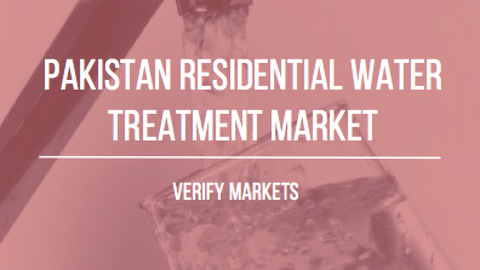2015 PAKISTANI RESIDENTIAL WATER TREATMENT MARKET
A comprehensive analysis of the Residential Water Treatment Market in Pakistan including market sizing, market share by competitor, drivers, restraints and market forecasts to 2021. This study is taken from the larger Global Residential Water Treatment Market report for 2015.
South Asia is a region which is assuming greater importance in world politics. One of the key members of the South Asian community is Pakistan. It is also an ally to the United States on various political issues, like maintenance of peace and stability in neighboring regions. For decades, Pakistan has been battling internal political disputes, among other problems. Additionally, the low rates of foreign investment into Pakistan are causing a slower rate of growth and development in the country. However, one of the biggest problems looming in front of this country is an impending water scarcity.
 According to a recent IMF report titled “Issues in managing water challenges and policy instruments: Regional perspectives and case studies”, Pakistan ranks 3rd among the world’s 36 most water stressed countries. It also has the world’s fourth largest rate of water use. The water scarcity threshold is 1,000 cubic meters per capita of annual water availability, and Pakistan’s current level is 1017 cubic meters. This is alarmingly close to the threshold and a cause of grave concern for its government, as well as the international community. This decline can be attributed to the fast growth in population and unrestrained usage. In areas where water is supplied, the quality is too poor to drink, by any standard.
According to a recent IMF report titled “Issues in managing water challenges and policy instruments: Regional perspectives and case studies”, Pakistan ranks 3rd among the world’s 36 most water stressed countries. It also has the world’s fourth largest rate of water use. The water scarcity threshold is 1,000 cubic meters per capita of annual water availability, and Pakistan’s current level is 1017 cubic meters. This is alarmingly close to the threshold and a cause of grave concern for its government, as well as the international community. This decline can be attributed to the fast growth in population and unrestrained usage. In areas where water is supplied, the quality is too poor to drink, by any standard.
It is estimated that every year, around 200,000 children lose their lives due to diarrheal diseases in Pakistan. To have a quantification of these facts, the Pakistan Medical Association (PMA) tested about 600 samples collected from a slum in Northern Karachi. The results were appalling. None of the 600 samples were fit for human consumption. These results are not limited to Karachi alone; the entire country is struggling with such problems. Slums are usually built on illegally occupied land, which makes it further difficult for slum dwellers to get legitimate water connections from the government. The local municipal corporations don’t allow these connections to be regularized, fearing that residents may usurp the land on the basis of water supply bills. That leaves people with either tapping into the groundwater resources or buying water from water tankers. Both these options also provide contaminated, non-potable water.
Now, a third option has started gaining popularity among urban as well as rural population called ‘water shops’. In a water shop, water is sold on a per-liter basis and the customer can see water being filled up from a purifier. This gives the processes in the shop more transparency and credibility. Water shops sell Reverse Osmosis (RO) purified water for PKR1.5 per liter (US $0.015), and the quality of this water meets the World Health Organization’s standards. The standard rate of RO water, if installed at home, is somewhere between PKR3.5 to PKR7 per liter.
An interesting thing to note is that Verify Markets have found this same trend in countries like South Africa, Indonesia, Thailand, certain parts of India, and some other Northern African and Middle Eastern countries. This trend has emerged in the last 5 years and is poised for healthy growth over the next 5 years.
Market Definition by Product
For the purposes of this study, a residential water treatment (RWT) system is defined as:
Point-of-entry (POE) systems: Point-of-entry or whole house systems treat all the water entering the home.
Point-of-use counter top (CT) systems: Counter top systems can either be placed on the kitchen counter or can be wall mounted (typically in Asia).
Point-of-use under-the-sink (UTS) systems: The UTS systems are usually placed under the kitchen sink and do not clutter the kitchen counter.
Point-of-use faucet mount (FM) systems: FM systems have small filters that go directly on the end of a faucet and are relatively easy to install. FM systems have low capacities and low flow rates as compared to pitchers and other types of water treatment systems.
Pitcher systems: These systems are also knows as jug filters in certain parts of the world. Water is filtered by gravity through a filter cartridge, mostly made up of carbon. Pitchers and faucet mount systems are cheap residential water treatment systems available to consumers.
Replacement filters: This study also covers replacement filters.

All reports are delivered in PDF via email within 1-12 hours of purchase. If immediate assistance is needed, please call +1.210.595.9687 and someone will help you right away.
Every report purchase comes with 1 hour of Analyst Inquiry Time for a phone call with our analysts. This can be used for strategic advice, consultation, or addressing issues in your business and linking them to a solution. Analyst Inquiry Time must be used within 45 days of report purchase.



